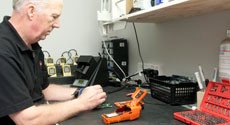
Lately I have been asked a number of questions regarding whether or not it is necessary to “zero” a portable gas monitor each time it is turned on for use.
It’s actually a great question, so what is zeroing a gas monitor?
As a matter of best practice, we train instrument users to perform four basic steps in clean air each time they turn their gas monitor on for use:
- Verify the battery charge level
- Zero
- Bump test
- Clear the peaks.
The key to this is knowing that you are in clean air.
You should never zero a gas monitor unless you know that you are in a clean-air environment.
Zeroing a gas monitor in a contaminated atmosphere can lead to confusion in the resulting readings and may even mask the readings of potentially dangerous concentrations of gas.
With all of that said, if you turn your gas monitor on and the combustible gas and toxic gas sensor readings are 000 and the oxygen sensor reading is 20.9, what is the purpose of zeroing the gas monitor?
Assuming that your gas monitor does not mask negative readings (no Industrial Scientific monitor does) there is none and zeroing the gas monitor at this point is of no benefit.
So, if you turn your gas monitor on and the readings are normal or within limits that are acceptable to you, there is no need to waste time going through the zeroing process. You won’t be any better or safer for it.
But in all cases, if you do zero a gas monitor, make sure you do so in clean air.
Until next time – be Safe and don’t hit the job site without your gas monitor.



Methane Gas detector.
How often do they need calibrating?
Thanks
Hi Paul,
The manufacturer’s recommendation for the calibration of the LEL sensor is monthly. This is based on the instrument being used daily for 8 hours. Our customers with their own calibration equipment often meet these requirements.
However, many New Zealand companies that only use the LEL sensor intermittently calibrate on a 6-monthly basis.
Hope that helps.
Cheers, John
what is the zero calibration gas for refrigerant ctx 300 egR134a,R404,R507,R407C
Hi John,
You’ve asked a really curly question there! The short answer is that I don’t know. I’ve reached out to a number of my expert international contacts and they have not been able to answer your question either.
Sorry I haven’t been able to come up with anything useful for you. I have to admit, it’s an unusual situation because I normally have an answer for everything!
Cheers, John
What could be wrong with personal gas monitors (5 gas) that after being zeroed in clean air and left in clean air for a number of hours, either drop in oxygen levels (around 19%vol) to the point where it alarms or steadily increase in oxygen again to the point where it alarms (around 24%vol.)? And have been recently calibrated?
Hi M, When an oxygen sensor has been recently calibrated but the readings increase or decrease, or both, after zeroing, we call this “drifting”. The cause of a drifting oxygen sensor is that the sensor is starting to fail. It may pass a calibration but then start drifting up, down or both. The only course of action in this instance is to replace the sensor. Cheers, John
Wwould it be usefull to add a PID to our new portable gas monitors we are about to purchase? This is for a fire department. We do not have a hazmati team and mostly use detectors after fires for air monitoring.
Hi Hil, yes, PIDs are best used by HAZMAT teams for fire investigations, and where the detection of low levels of VOCs may be critical to verifying that the immediate area is free of toxic and combustible VOCs.
In this situation, PIDs should be used in conjunction with all possible O2, combustible and toxic sensors.
The best combination of sensors for frontline firemen in post-fire salvage, clean-up and overhaul are CO, HCN and O2.
For confined space rescue, the most common sensors are O2, LEL, CO and H2S.
A good free app to download is “Gas detection Made Easy” by Industrial Scientific. It’s available in Apple App Store and Google Play Store.
Cheers, John
Hi
I can’t zero methane gas detector ( crowcon xgard model)
The current is not less than 6 mA
How can the problem be solved?